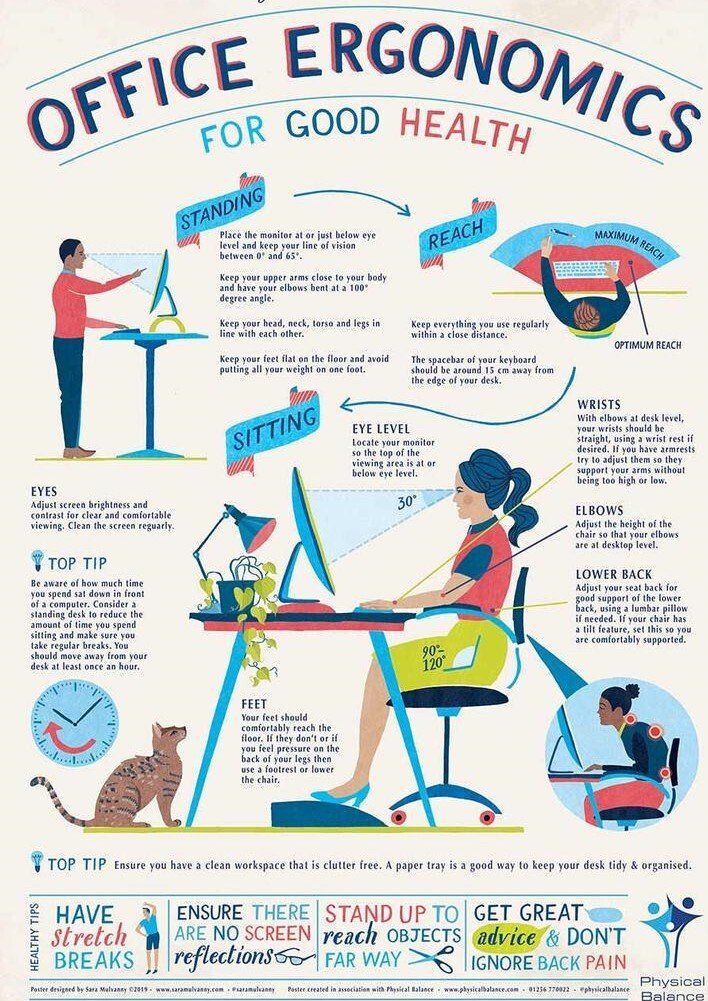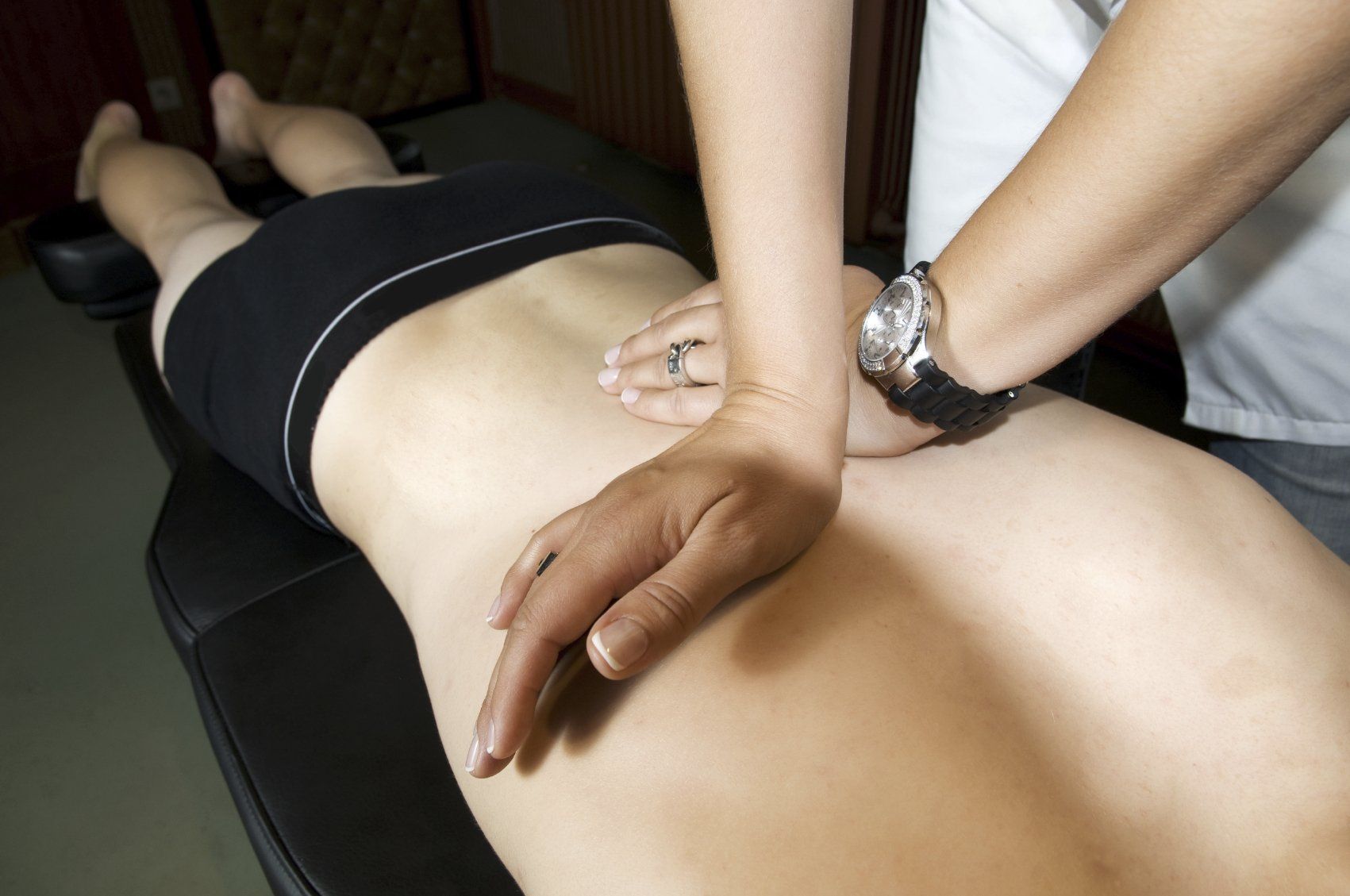Resources

Working in an office can make it hard to keep a healthy routine. It can be especially challenging for moms and dads who juggle work and home life. It seems like there is no time for yourself, especially making time to exercise or eat right. Here are a few tips to keep your work life as healthy as it can be. 1. While at work, work and then leave work at work. This seems obvious. But how many of us schedule birthday parties, car pool, and dance class while we are work? We also check Facebook, emails and return calls. As moms we are juggling 500 things at one time. Set aside time to return calls and emails, but while at the office commit to getting your work done so you don’t fall behind and need to bring it home with you. Organizing and prioritizing your day helps to keep you more focused and balanced 2. Sit on a ball or get a standing desk This day in age, sitting is the new smoking. As humans we are not designed to sit for most of the day. Our bodies are meant to be upright and active. Sitting for long periods of time leads to back pain, headaches, tight muscles and increased incidence of injury. What mom has time for that? A good alternative is sitting on a ball. This helps to strengthen your core, which will help to prevent back injuries. Another great, highly recommended alternative is to opt for a sit-stand desk. This allows you to spend more time standing in an upright position for most of the day while working. By standing you will help to prevent tightness in your lower back and hips. Plus, you will burn more calories which will help to keep that baby weight off. 3. Make your work station ergonomic. Many corporate offices offer ergonomic checks. They will set your computer and desk chair at the appropriate height for you. This allows you to sit with better posture, which will decrease computer neck strain, carpal tunnel and other work related injuries. 4. Every 30 minutes get up and take a break Your body and your mind need a break from the computer screen. Every thirty minutes move away from your desk and take a one-minute break from the screen. Get water, run to the bathroom, or visit a coworker will help you to reset and refocus. 5. Bring your lunch It is easy to get caught up in the sweet treats at your office. It is also easy to grab fast food during your short lunch hour. Packing a well balanced healthy lunch will help you to stay focused throughout the day. No need to worry about that full sleepy feeling after eating the salad or soup you packed. It is helpful to meal prep over the weekend so you can just grab and go during your busy morning. 6. Drink water, and only water Water will keep you hydrated and satisfied. Try to avoid energy drinks, sodas and coffees that are high in sugar. This can cause you to crash later in the day and feel bloated and tired. Who wants to attend that meeting with the CEO with a bloated belly and sleepy eyes? Try adding lemon to your water for flavor. Another good alternative if you crave carbonation is seltzer water. 7. Mediate Take a minute here and there to closes your eyes and mediate. This will help you to regroup. Deep breathing has been shown to decrease stress and anxiety. Breath in for a count of 10 and breath out for another count of 10. Try it, you will feel amazing after! 8. Diffuse essential oils The new craze is essential oils and I just love it! They can help you to breath better, focus more, and decrease stress. Try getting a small diffuser and add some lavender oil to it on high stress days. Need energy to meet that deadline? Diffuse some lemon or orange oil. 9. Move More. On those 30-minute breaks you should be taking, do some neck, hip and wrist stretches. Stretching will help to get your blood flowing, which will give you more energy. It will also help to prevent tightness and pain by the end of the day. Here are a few tips to make your workday a little healthier. It can be very challenging to be a working parent but just a few simple moves throughout the day can help you to be more productive and less stressed.

The Webster technique is a specific chiropractic analysis and diversified adjustment. The goal of the adjustment is to reduce the effects of sacral subluxation/ SI joint dysfunction. In so doing neuro-biomechanical function in the pelvis is improved. The Webster Technique is a specific chiropractic analysis and adjustment to a woman’s pelvic region which reduces the interference to the nervous system and creates balance in the pelvic structures, muscles and ligaments. By reducing nervous system interference, improved function of the pelvic muscles and ligaments lead to the reduction of constraint in the woman’s uterus, allowing the baby to get into the best possible position for birth. The Webster Technique is used when a misaligned pelvis causes the tightening and torsion of specific pelvis muscles and ligaments. It is these tense muscles and ligaments and their constraining effect on the uterus, which prevents the baby from achieving the best possible position for birth. At the time of your fist visit, the doctor will talk to you about your pregnancy and any concerns. You will then be assessed for the Webster Technique. You will lay face down on specific tables and pillow toppers, on the chiropractic table which releases for your belly. While you are face down, the doctor will flex your legs up to your buttocks which helps to identify which side of the pelvis needs to be adjusted. The adjustment will be delivered by using Drop Table Technique where the lower part of the table is raised one inch and when the adjustment is made by the doctor the table will drop one inch to accentuate the gentle force the doctor uses. After the adjustment is delivered the doctor will check the leg length again. At this point some very mild muscle work to release the sacral ligaments. Next you will flip over face up and the doctor will assess for round ligament tenderness and tightness and tautness in the psoas muscles. Corrections are done by using very minimal pressure to release the tension on the ligament. We encourage patients to start treatment as soon as they become pregnant. This will help to keep the pelvis aligned properly while the body is changing due to the growth of the baby. We also recommend that you bring a significant other who will be with you during the birth as we will show them gentle massage techniques to do while you are in labor.
What Is a Tongue or Lip Tie? First, lets look at what tongue and lip ties are. A tongue tie is when the frenulum, or band of connective tissue that connects the tongue to the bottom of the mouth, causes restriction in the motion of the tongue. A lip tie is when the frenulum that connects the upper lip to the gums causes a restriction in the motion of the lip or causes structural change to the gums. There are also buccal ties that can occur too. These are less common but they form along the upper gum more towards the back teeth on either side. These connect the upper gum to the inner cheek. There are different grades to identify the type of lip and tongue tie, and is best done by your pediatric dentist, ENT, pediatrician or chiropractor. Why Do People Have Lip or Tongue Ties? So now that we know what we are looking at, let’s look at why this occurs. There are still so many unknowns as to why this occurs during development and often times can be genetically related. The frenulum normally thins and recedes before birth. Where this doesn’t happen, the frenulum may restrict tongue mobility. There is an association between high or unusual palates and tongue tie, because restricted tongue movement can affect the shape of the palate. What are Common Symptoms of a Lip or Tongue Tie? Lip and tongue ties can be difficult to diagnose, but there are some common symptoms that occur when a lip or tongue tie is present. Babies can have difficulty nursing. This can manifest as a painful latch or pain while suckling, clicking, choking or gaging while nursing especially upon milk letdown, inability to transfer milk affectively (this leads to more frequent nursing), shallow latch, or all together an inability to latch. Babies may also have digestive symptoms such as reflux, gassiness, spitting up, or colic. As the mother you may experience pain while nursing, creased or flat nipples after nursing, dryness or cracks on the nipple due to too much friction while nursing, clogged milk ducts, mastitis, or low milk supply. While these are not symptoms exclusive to lip and tongue ties, they are very common symptoms that should influence you toward getting evaluated by a professional. What Can be Done? Once it is determined that your baby has a lip or tongue tie there are a few options to help resolve the issue. Non invasive solutions include bodywork, myofascial therapy, chiropractic care, and craniosacral therapy. These focus on releasing the tight connective tissue, improving structural alignment, and increasing cranial and dural motion. This can be helpful in cases where the ties are not as severe and there are more mild symptoms. However, a more invasive treatment may be necessary. There are different types of frenectomy procedures that are available and should be discussed in detail by your provider. After care requires stretches every few hours to prevent reattachment. Once the revision is performed it is ideal to have bodywork, craniosacral therapy or chiropractic care to help release and unwind any underlying restrictions that still remain. The ties are like the tip of the iceberg, there can be a lot of underlying restriction and tightness that is not obvious, but can continue to affect function. Results after the revision can vary quite a bit. Some mothers notice an immediate improvement and can feel like the revision completely corrected all the problems. However, there are times when there seems to be little to no immediate improvement. This is when bodywork and chiropractic care is especially necessary. The underlying tightness needs to be released in order to notice improvement and is necessary when attempting suck retraining exercises. If there are still restrictions within the cranium, jaw, neck, upper back and throat, then nursing and suck retraining exercises are going to be hindered. Retraining exercises can be given to you by your providers. What Can Happen if Nothing is Done? So what can happen if you decide to leave the tongue or lip tie alone and not pursue any revision or fascial therapy? There are many possibilities. One being that there may not be any obvious issues, adaptations, or symptoms later in life. However, with the abnormal structure present of a lip and/or tongue tie there will be adaptations necessary, obvious or not, and there is a likelihood that other symptoms would arise. Some common symptoms are speech difficulties, gapping in the teeth, early or worsened tooth decay, narrow maxillary and mandible (jaw) development causing sinus problems or TMJ issues, headaches, neck/upper back/shoulder pain and tightness, reflux, digestive issues, torticollis, plagiocephaly and possibly others. Speech issues can be an obvious sign if the child was not diagnosed with a tie earlier. Most children will have trouble with R, S, L, Z, D, N, T, Y, K, -NG, CH, TH, SH, and –dge although other sounds may be difficult as well. Having a tongue tie can lead to mouth breathing which can contribute to asthma, allergies, sleep apnea, snoring, and enlarged tonsils/adenoids. Ear infections may be more prominent in someone with a tongue tie because the back of the tongue can not elevate enough to equalize the pressure in the Eustachian tubes. This can lead to fluid build up that can not drain properly, allowing for an environment for the growth of a bacteria or virus. When children get older the swallow mechanics are altered due to the tongue tie and can affect drinking from a straw or how the child is able to swallow foods. What Needs to Be Done After a Revision? If you choose to have the lip and tongue ties revised. there are several things to be aware of and to include in the care of your child. As mentioned earlier, there are varied degrees of improvement in symptoms with the frenectomy. Stretches for the tongue and lip should be shown to you at the time of the frenectomy and are typically done every few hours for the first 1-2 weeks and continued at a less frequent rate until the tissue is fully healed (about 1 month). Suck retraining exercises may be necessary to help strengthen the muscles necessary for a good latch and proper suckle. Bodywork, Craniosacral Therapy, and/or chiropractic care is very important regardless of the degree of tie and regardless of the type of symptoms you see. Very commonly, those with lip and tongue ties also have a tight dural tube. The dural tube is the connective tissue that surrounds the nervous system, the brain and spinal cord down to the sacrum. Unwinding the tightness in the dura and throughout the body will help your child feel more at ease and comfortable. Tummy time is another important addition to care after a frenectomy. Tongue and lip ties affect cranial nerve function, restrict normal range of motion and can diminish the baby’s ability to develop proper head control. Along with removing restrictions by utilizing chiropractic care and bodywork, having your baby build the muscles responsible for head control and movement helps to strengthen cranial nerve function and encourage a proper development. It is important to remember that not every child is the same and there are so many variables that can impact the decision of how to care for your child’s lip and/or tongue tie. Not every tongue tie will need a frenectomy. Some children can reestablish proper function just through chiropractic care and bodywork. Other children may need a frenectomy to be able to reestablish proper function. Tongue ties and lip ties can be a complex and sometimes overwhelming issue to navigate. However, with the right team of care providers on your side it can become a lot more manageable; and you can rest assured you are doing everything you can to help you and your baby thrive together.

CONGRATULATIONS ON YOUR BABY! My goal is to make your pregnancy the best it can be. Why should I have chiropractic care during pregnancy? During pregnancy, there are several physiological and endocrinological changes that occur in preparation for creating the environment for the developing baby. The following changes can result in a misaligned spine or joints: Protruding abdomen and increased back curve Pelvic changes Postural adaptations Establishing pelvic balance and alignment is another reason to obtain chiropractic care during pregnancy. When the pelvis is misaligned it may reduce the amount of room available for the developing baby. This restriction is called intrauterine constraint. A misaligned pelvis may also make it difficult for the baby to get into the best possible position for delivery. This can affect the mother’s ability to have a natural, non-invasive birth. Breech and posterior positions can interfere with the natural ease of labor and lead to interventions such as c-sections. By balancing the pelvis we are able to make space for baby to get in their ideal position for delivery. The nervous system is the master communication system to all the body systems including the reproductive system. Keeping the spine aligned helps the entire body work more effectively. What are the benefits of chiropractic care during pregnancy? Chiropractic care during pregnancy can provide benefits for women who are pregnant. Potential benefits of chiropractic care during pregnancy include: Maintaining a healthier pregnancy Controlling symptoms of nausea Reducing the time of labor and delivery Relieving back, neck or joint pain Preventing a potential cesarean delivery Decreasing pain and symptoms due to sciatica, pubic symphysis diastasis, carpal tunnel and more. Studies have shown that chiropractic care during pregnancy may decrease labor time by 50% and decrease the need for pain medications during labor.

Getting out of bed ...... when suffering from back pain⚡️, preventing back pain or Pregnant🤰🏽 • Back pain is the biggest single cause of disability on the 🌎 Prevention is key to help reduce this chronic condition, but even simple activities like getting out of bed can cause or exacerbate back pain if done incorrectly. • This 🎥 demonstrates how to roll out of bed without putting excessive stress or strain on the back👌🏼 • 🎥 1️⃣Bend one knee, bringing the leg up ⭐️Use the leg 𝙤𝙥𝙥𝙤𝙨𝙞𝙩𝙚 of the side you are getting up on {getting out on 𝙧𝙞𝙜𝙝𝙩 𝙨𝙞𝙙𝙚 bring up 𝙡𝙚𝙛𝙩 𝙡𝙚𝙜 }⭐️ 2️⃣Bring the bent leg across your body 3️⃣Slowly roll upper body onto side 4️⃣Place palm of hand on bed 5️⃣Using this hand push yourself up 6️⃣Swing legs over the side as you sit up 7️⃣Put hands on thighs and push up to standing🙌🏼 • Try it out & let us know✌🏼

Feeling hunched after a long week? • Long days looking down at the computer, phone, kids or breast feeding— can cause the trap and serratus muscle in the back to become weak + stretched out🚶🏽♀️. These 👇🏼 exercises help target the muscles that hold your shoulders back and down. • 🎥☝🏼Exercise Mid & Lower Traps 1.Keeping shoulder back against the wall, start with arms in W 2.Slowly move arms up into Y, trying to keep your shoulders and arms against the wall 3.Engage (try to feel) mid back muscles as you bring your arms down Repeat 2x10 Questions? Comments? Let us know!
